Closing the City Cycle: An Approach for Defining Cross-Sectoral Circular Actions to Be Included in a Circular Urban Plan
Abstract
1. Introduction
- Buildings designed to be modular and flexible;
- An accessible, economical, clean, and effective urban mobility system;
- Resilient, renewable, distributed energy systems that enable effective energy use;
- Balance in the urban bio-economy, where nutrients are returned to the soil;
- Production systems that encourage “local value loops” and minimize waste.
2. Materials and Methods
2.1. Circular Actions
2.2. Proposed Methodology
2.3. Case Study: The City of Genoa and Circularity
- Preliminary report on city circular economy initiatives (short term);
- Development of a flexible circular economy strategy (short term);
- Research and innovation projects on new sustainable and circular product chains (short term);
- Identification and characterization of potential experimentation sites (short term);
- Implementation of new circular economy initiatives (medium term);
- Experimentation of a circular district (Circular Hub and idea laboratory) (medium term);
- Partnership agreements on technologies in the bio-economy field (medium term).
3. Results
3.1. Applying the Methodology to the Case Study: Towards the Closure of the Genoa Cycle
4. Discussion and Conclusions
Author Contributions
Funding
Institutional Review Board Statement
Informed Consent Statement
Data Availability Statement
Acknowledgments
Conflicts of Interest
Appendix A
| DATABASE ACTIONS CROSS-SECTORAL CLOSURE | ||||||
|---|---|---|---|---|---|---|
| KEY SECTOR | Mobility | Waste | Built Environment | Water | Energy | Food |
| Mobility |
|
|
|
|
|
|
| Waste |
|
|
|
|
| |
| Built Environment |
|
|
|
| ||
| Water |
|
|
| |||
| Energy |
| / | ||||
| Food |
| |||||
| GOOD PRACTICES/ACTIONS—WATER | DESCRIPTION |
|---|---|
| Initiative/Event | |
| Blue Economy Summit | The Summit’s overall objective was to create awareness of the opportunities deriving from the ‘Blue Economy’, or ‘Economy of the Sea’, by involving all the main institutional and entrepreneurial players in the area that use the sea as a resource for industrial activities and the development of services, placing them in a context of sustainability. Several targets were reached during the Summit, including: International, European and Italian institutions, academic and research institutions, international and national associations, Italian and European local authorities bearers of case-histories, public and private companies, local institutions representing sectors related to infrastructure, smart cities, environment, energy, mobility, culture, tourism and local, national and international media. The themes addressed during these editions are:
|
| TheOcean Race—Genoa Grand Finale 2022—2023 | The Ocean Race, (formerly Whitbread Round the World Race), is the most prestigious, longest and toughest round-the-world sailing competition for professional crews, held every three years. The city of Genoa has allowed Italy to be present and protagonist of this epic event for the first time, through the organization of the Grand Finale of the 2022—2023 edition. The event, articulated in 10 international stages: Alicante—Cape Verde—Cape Town—Shenzhen—Auckland—Itajai—Newport—Aarhus—The Hague—Genoa, represented first and foremost an extraordinary opportunity for Genoa and Sistema Italia to promote and develop social, cultural, scientific and economic development. The sea and the port and all the related activities represent one of the fundamental assets for the economic development of the city and, therefore, The Ocean Race was a fundamental driving force to exploit every opportunity to reaffirm and promote Genoa as the European capital of the blue economy (sustainability, Maritime Transport, Marine Waste Management, Renewable Energies, Tourism, Oceans and Climate Change) and the centrality of the port of Genoa and its role in the Mediterranean. Founding elements of a new great season for the city of Genoa at the service of Italy and Europe. |
| Place | |
| Genoa Blue District | The blue economy represents one of the Administration’s main drivers. Given the territorial conformation and the specialization of the supply chain that is intended to be strengthened in the area, an aggregation and facilitation project linked to the blue economy has been launched, with the establishment of the Genoa Blue District as its highest expression. The Warehouses of Abundance (or Palazzo Verde) have been identified as the physical configuration space of this project. The geographical location in the area of the old port represents the incipit of a path of identity creation around the theme of the Blue Economy in terms of business innovation, as well as economic development and networking. The Genoa Blue District is a modular project that brings together a heterogeneity of actions gravitating around 3 main themes
|
| Implementation project | |
| SIMAM2—Leachate and groundwater purification | The substance called leachate, produced in any landfill, is a polluting liquid also containing ammonia, nitrogen and metals that is formed when rainwater runs through the waste and, as it flows, collects the waste and chemical components present. The leachate produced in this way is collected by a capillary system of pipes and wells, which conveys it into two large tanks located at the foot of the landfill. From there it is sent to the ‘SIMAM2’ treatment plant, where, thanks to the reverse osmosis purification system, it is treated and finally discharged into the sewage system. During the experimental campaign in the spring of 2019, in agreement with the company Simam, a specially designed process was developed for the treatment of the leachate concentrate, which makes it possible to obtain a concentrated solution of ammonium sulphate, which can be valorized on the market for the formulation of fertilizers for agricultural use. The estimated annual production of ammonium sulphate is around 3700 tons. In January 2020, AMIU filed an application to introduce improvements to the SIMAM2 plant’s purification cycle. Pending the issuance of the permit, work was carried out to adapt the plant to the new configuration, through the installation of specific equipment. In addition, in December 2021, AMIU was granted the possibility of disposing of sludge from leachate treatment operations directly in the landfill. This solution will provide a double economic and environmental advantage: it will no longer be necessary to transfer the sludge by tanker trucks to other plants, with a consequent reduction in transport costs and CO2 produced. From the point of view of water consumption, in the new configuration the consumption of water taken from the aqueduct will be less than 1 m3/day. This reduction was also possible thanks to the reuse of permeate (the main product of the purification process) as industrial water. |
| viAmare | The ‘viAmare’ project derives from the strategy of the Genoa Metropolitan City’s Sustainable Mobility Plan to strengthen local public transport complementary to LPT and as an alternative to the use of private cars and is integrated with soft mobility systems (urban cycle paths and cycle-tourist routes). It is also a project for the sustainable enhancement of the territory since the viAmare service can support the tourist offer. In fact, the service, in addition to providing stopovers at the main tourist resorts on the Rivieras, is designed to integrate with the Tyrrhenian national tourist cycle route and connect with the interchange nodes at Cristoforo Colombo Airport and the new waterfront in Genoa. The service addresses the challenge of the transport sector’s energy transition by incentivizing the transfer from private cars to LPT, with a consequent annual reduction in private journeys, and proposes—depending on the scenario considered basic or congested—an annual reduction in CO2 emissions from road traffic, thanks also to the green propulsion systems of the innovative, low-input prototype ships, which are also the subject of the project. On the basis of a sample survey, a project was carried out to demonstrate the feasibility of a segmented transport service on three lines: Linea Centro da Prà a Nervi—con approdo a Pegli, Aeroporto, Porto Antico e Fiera, Linea Ponente si svilupperà invece dall’Aeroporto a Savona con scalo ad Arenzano e Varazze Linea Levante, infine, partirà dalla Fiera, con approdo a Recco, Santa Margherita Ligure, Rapallo, Chiavari e Sestri Levante. |
| Central Area Water Purifier | A large “Depuratore area centrale” (D.A.C.) is being built in the disused areas of Genoa’s “Ex Ilva” steel mill, which will rise at the mouth of the Polcevera River, on the right bank in the former Ilva area, thus creating one of the largest sewage treatment plants in Italy and Europe. The operation, under an Integrated Contract won by the consortium Consorzio Integra, Veolia Water Technologies Italia and Suez Trattamento Acque and carried out by the company ICI.COOP SpA, will cost about 60 million euros and is considered a Strategic intervention in the Plan of Program Interventions approved by the Metropolitan Council: in fact, it will also allow the redevelopment of Via Rolla in the Campi area of Cornigliano, in accordance with the Metropolitan City’s P.U.C. Genoa’s current sewage system in fact consists of numerous plants, distributed throughout the territory following the particular local morphological and urban conformation, some of which are obsolete, causing a series of management and functional criticalities that can only be overcome through a general reorganization of the city’s sewage system. The new D.A.C., in addition to treating wastewater generated by the Polcevera Valley basin, will be able to receive sludge from the entire city’s sewage treatment system (with a design pollutant load amounting to 250,000 A.E), simplifying its management and making possible upgrades of other plants. Its construction is functional in the pursuit of the following objectives, which are of particular importance for the current historical moment of energy efficiency and environmental impact:
|
| European/supranational Project | |
| EcoeFISHent | EcoeFISHent is the Horizon 2020 project coordinated by FILSE—Finanziaria Ligure per lo Sviluppo Economico—which involves no less than 35 Italian and European entities, including AMIU and its affiliate GEAM. EcoeFISHent will support the growth of the local fishing sector through innovative development models based on circular economy principles. Among the main objectives are: the creation of sustainable packaging for fishing; the production of alternative fertilizers for agriculture from waste, biodiesel oil for the food, cosmetic, biomedical and pharmaceutical industries; and the reduction of the amount of plastic marine waste; the initiation of actions to preserve biodiversity and the balance and health of the ecosystem. Other objectives are to use better and cutting-edge technologies, optimize logistics and the impact of transport, all supported by an app (SeAPP) that allows the monitoring of vehicles, goods, materials and financial flows within the relevant territory. |
| INFUSION | Funded under the LIFE Programme, the main objective of the INFUSION project is to improve the current treatment of wastewater from the treatment of municipal waste through a series of technological processes that do not destroy the nutrients contained in this water. The project aims to close the loop between waste and resources in landfills and waste management plants by reducing their social, economic and environmental impact (recovering energy, nutrients and water from landfill leachate and liquid digestate from the organic fraction of municipal solid waste; reducing the environmental impact of liquid FORSU digestate and landfill leachate generated in municipal solid waste treatment plants; and disseminating the project results to other regions by extending it to other sectors with similar effluents). To achieve these objectives, the technology will be implemented in two pilot plants: at the Europarc2 plant in Besòs (Montcada i Reixac, Barcelona) and at the Cogersa plants in Gijón (Asturias). In 2021, the technology design was successfully completed and tested on a laboratory scale. |
References
- IPCC. Contribution of Working Group III to the Sixth Assessment Report of the Intergovernmental Panel on Climate Change; Shukla, P.R., Skea, J., Slade, R., Al Khourdajie, A., van Diemen, R., McCollum, D., Pathak, M., Some, S., Vyas, P., Fradera, R., et al., Eds.; Climate Change 2022: Mitigation of Climate Change; Cambridge University Press: Cambridge, UK, 2022. [Google Scholar]
- Russo, M.; van Timmeren, A. Dimensions of Circularity for Healthy Metabolisms and Spaces. In Regenerative Territories; GeoJournal Library; Amenta, L., Russo, M., van Timmeren, A., Eds.; Springer: Cham, Switzerland, 2022; Volume 128. [Google Scholar]
- Williams, J. Circular cities: Planning for circular development in European cities. Eur. Plan. Stud. 2023, 31, 14–35. [Google Scholar] [CrossRef]
- Bortolotti, A.; Verga, G.C.; Khan, A.Z. Which circularity for urban design and planning? A compass to navigate circular economy research knowledge and methods. Plan. Pract. Res. 2023, 1–20. [Google Scholar] [CrossRef]
- Hobson, K. Closing the loop or squaring the circle? Locating generative spaces for the circular economy. Prog. Hum. Geogr. 2016, 40, 88–104. [Google Scholar] [CrossRef]
- Marin, J.; Meulder, B.D. Interpreting Circularity. Circular City Representations Concealing Transition Drivers. Sustainability 2018, 10, 1310. [Google Scholar] [CrossRef]
- Pomponi, F.; Moncaster, A. Circular economy for the built environment: A research framework. J. Clean. Prod. 2017, 143, 710–718. [Google Scholar] [CrossRef]
- Prendeville, S.; Cherim, E.; Bocken, N. Circular Cities: Mapping Six Cities in Transition. Environ. Innov. Soc. Transit. 2018, 26, 171–194. [Google Scholar] [CrossRef]
- Verga, G.C.; Khan, A.Z. Space Matters: Barriers and Enablers for Embedding Urban Circularity Practices in the Brussels Capital Region. Front. Built Environ. 2022, 8, 810049. [Google Scholar] [CrossRef]
- Ellen MacArthur Foundation. Cities in the Circular Economy: An Initial Exploration. 2017. Available online: https://www.ellenmacarthurfoundation.org/publications/cities-in-the-circular-economy-an-initial-exploration (accessed on 9 July 2024).
- UN General Assembly. Transforming Our World: The 2030 Agenda for Sustainable Development. 2015. Available online: https://undocs.org/en/A/RES/70/1 (accessed on 9 July 2024).
- Brundtland, G.H. Our Common Future: Report of the World Commission on Environment and Development; UN-Dokument A/42/427; UN-Dokument: Geneva, Switzerland, 1987. [Google Scholar]
- Circular City Declaration. What Is a Circular City, a Circular City Definition. 2020. Available online: https://circularcitiesdeclaration.eu/ (accessed on 9 July 2024).
- Ugolini, P. Approccio Alla Sostenibilità Nella Governance del Territorio. In Collana Città e Territorio; Franco Angeli: Milan, Italy, 2010. [Google Scholar]
- World Business Council for Sustainable Development. Full Report—Mobility 2030: Meeting the Challenges to Sustainability. 2004. Available online: https://www.wbcsd.org/wp-content/uploads/2024/06/Mobility2030-FullReport.pdf (accessed on 9 July 2024).
- Campbell, S. Green cities, growing cities, just cities? Urban planning and the contradictions of sustainable development. J. Am. Plan. Assoc. 1996. [Google Scholar] [CrossRef]
- Lélé, S.M. Sustainable development: A critical review. World Dev. 1991, 19, 607–621. [Google Scholar] [CrossRef]
- World Bank. World Bank Report: Cities and Climate Change: An Urgent Agenda. 2010. Available online: http://documents.worldbank.org/curated/en/194831468325262572/Cities-and-climate-change-an-urgent-agenda (accessed on 9 July 2024).
- Petit-Boix, A.; Leipold, S. Circular economy in cities: Reviewing how environmental research aligns with local practices. J. Clean. Prod. 2018, 195, 1270–1281. [Google Scholar] [CrossRef]
- Bolger, K.; Doyon, A. Circular cities: Exploring local government strategies to facilitate a circular economy. Eur. Plan. Stud. 2019, 27, 2184–2205. [Google Scholar] [CrossRef]
- Paiho, S.; Mäki, E.; Wessberg, N.; Paavola, M.; Tuominen, P.; Antikainen, M.; Heikkilä, J.; Rozado, C.A.; Jung, N. Towards circular cities—Conceptualizing core aspects. Sustain. Cities Soc. 2020, 59, 102143. [Google Scholar] [CrossRef]
- Casazza, M.; Xue, J.; Du, S.; Liu, G.; Ulgiati, S. Simulations of scenarios for urban household water and energy consumption. PLoS ONE 2021, 16, e0249781. [Google Scholar] [CrossRef] [PubMed]
- Voskamp, I.M.; Sutton, N.B.; Stremke, S.; Rijnaarts, H.H.M. A systematic review of factors influencing spatiotemporal variability in urban water and energy consumption. J. Clean. Prod. 2020, 256, 120310. [Google Scholar] [CrossRef]
- Hofstetter, J.S.; De Marchi, V.; Sarkis, J.; Govindan, K.; Klassen, R.; Ometto, A.R.; Spraul, K.S.; Bocken, N.; Ashton, W.S.; Sharma, S.; et al. From Sustainable Global Value Chains to Circular Economy—Different Silos, Different Perspectives, but Many Opportunities to Build Bridges. Circ. Econ. Sustain. 2021, 1, 21–47. [Google Scholar] [CrossRef]
- Mabhaudhi, T.; Nhamo, L.; Chibarabada, T.P.; Mabaya, G.; Mpandeli, S.; Liphadzi, S.; Senzanje, A.; Naidoo, D.; Modi, A.T.; Chivenge, P.P. Assessing Progress towards Sustainable Development Goals through Nexus Planning. Water 2021, 13, 1321. [Google Scholar] [CrossRef]
- Nhamo, L.; Ndlela, B. Nexus planning as a pathway towards sustainable environmental and human health post COVID-19. Environ. Res. 2021, 192, 110376. [Google Scholar] [CrossRef]
- Williams, J. Circular Cities: What Are the Benefits of Circular Development? Sustainability 2021, 13, 5725. [Google Scholar] [CrossRef]
- Salvo, V.D.; Carraro, M.; Bianchini, M.; Maffei, S. Validating collaborative practices for urban circular economy: The design perspective. TECHNE—J. Technol. Archit. Environ. 2021, 22, 122–130. [Google Scholar] [CrossRef]
- Antikainen, M.; Uusitalo, T.; Kivikytö-Reponen, P. Digitalisation as an Enabler of Circular Economy. Procedia CIRP 2018, 73, 45–49. [Google Scholar] [CrossRef]
- Eit Climate-KIC. Digitalisation—Unlocking the Potential of the Circular Economy; Eit Climate-KIC: Berlin, Germany, 2019. [Google Scholar]
- Pagoropoulos, A.; Pigosso, D.C.A.; McAloone, T.C. The emergent role of digital technologies in the circular economy: A review. Procedia CIRP 2017, 64, 19–24. [Google Scholar] [CrossRef]
- Mazzarella, C.; Amenta, L. The Circular Metabolic Urban Landscape. In Regenerative Territories; GeoJournal Library; Amenta, L., Russo, M., van Timmeren, A., Eds.; Springer: Cham, Switzerland, 2022; Volume 128. [Google Scholar] [CrossRef]
- Lucertini, G.; Musco, F. Circular Urban Metabolism Framework. One Earth 2020, 2, 138–142. [Google Scholar] [CrossRef]
- Langergraber, G.; Pucher, B.; Simperler, L.; Kisser, J.; Katsou, E.; Buehler, D.; Mateo, M.C.G.; Aatanasova, N. Implementing nature-based solutions for creating a resourceful circular city. Blue-Green Syst. 2020, 2, 173–185. [Google Scholar] [CrossRef]
- Remøy, H.; Wandl, A.; Ceric, D.; Timmeren, A.V. Facilitating circular economy in urban planning. Urban Plan. 2019, 4, 1–4. [Google Scholar] [CrossRef]
- Dabrowski, M.; Varjù, V.; Amenta, L. Transferring Circular Economy Solutions across Differentiated Territories: Understanding and Overcoming the Barriers for Knowledge Transfer. Urban Plan. 2019, 4, 52–62. [Google Scholar] [CrossRef]
- Ispra. Qualità dell’Ambiente Urbano VI Rapporto ISPRA Focus Sulle Buone Pratiche Ambientali. 2009. Available online: https://www.isprambiente.gov.it/files/pubblicazioni/statoambiente/3908_focus_buone_pratiche.pdf (accessed on 9 July 2024).
- Fassio, F.; Cionchi, E.; Tondella, A. La Circular Economy for Food Nelle Città del Futuro. Buone Pratiche per la Definizione di Smart Food. AGATHÓN. 2020. Available online: https://www.agathon.it/agathon/article/download/223/242 (accessed on 9 July 2024).
- Fusco Girard, L.; Nocca, F. Il modello di città circolare come modello di sviluppo per le città di piccola, media e grande dimensione. BDC—Boll. Del Cent. Calza Bini 2019, 19, 305–337. [Google Scholar] [CrossRef]
- ENEA. Linea Guida Buone Pratiche di Economia Circolare Volume 1. 2021. Available online: https://www.icesp.it/sites/default/files/2021-12/ICESP_lineaguida_2021_def.pdf (accessed on 9 July 2024).
- Italian Circular Economy Stakeholder Platform. 2021. Available online: https://www.icesp.it/buone-pratiche (accessed on 26 February 2024).
- European Commission Good Practice Library. 2022. Available online: https://green-business.ec.europa.eu/green-public-procurement/good-practice-library_en (accessed on 4 March 2024).
- Paoli, F.; Pirlone, F.; Spadaro, I. Il Piano urbano di azione circolare partecipato come strumento innovativo di governance. In Proceedings of the Atti della XXV Conferenza Nazionale SIU—Società italiana degli Urbanisti Transizioni, Giustizia Spaziale e Progetto di Territorio, Cagliari, Italy, 15–16 June 2023. [Google Scholar]
- Kirchherr, J.; Reike, D.; Hekkert, M. Conceptualizing the circular economy: An analysis of 114 definitions. Resour. Conserv. Recycl. 2017, 127, 221–232. [Google Scholar] [CrossRef]
- Kisser, J.; Wirth, M. The Fabrics of a Circular City. In An Introduction to Circular Economy; Liu, L., Ramakrishna, S., Eds.; Springer: Berlin/Heidelberg, Germany, 2021. [Google Scholar] [CrossRef]
- Comune di Genova—Direzione Sviluppo Economico, Progetti d’Innovazione Ufficio Agenda Urbana e Transizione Ecologica. Genova 2050 Action Plan per Una Lighthouse City. 2021. Available online: https://www.investingenova.com/sites/default/files/archivio/download/Action-Plan-Def-digitale.pdf (accessed on 9 July 2024).
- Sistema Nazionale per la Protezione dell’Ambiente. Città in Transizione: I Capoluoghi Italiani verso la Sostenibilità Ambientale. Documento di Valutazione Integrata della Qualità dell’Ambiente Urbano. 2022. Available online: https://www.snpambiente.it/wp-content/uploads/2022/07/DVI_2022_Citta-in-transizione_finale.pdf (accessed on 9 July 2024).
- Paoli, F.; Pirlone, F.; Spadaro, I. A Participatory Mapping for Planning a Circular City. In Innovation in Urban and Regional Planning. INPUT 2023; Lecture Notes in Civil Engineering; Springer: Cham, Switzerland, 2023. [Google Scholar] [CrossRef]
- Dessi, V.; Farnè, E.; Ravanello, L.; Salomoni, M.T.; Regione Emilio-Romagna, Politecnico di Milano. Rigenerare la città con la Natura. Strumenti per la Progettazione degli Spazi Pubblici tra Mitigazione e Adattamento ai Cambiamenti Climatici. Maggioli Editore, Santarcangelo di Romagna. 2018. Available online: https://re.public.polimi.it/retrieve/e0c31c0c-175f-4599-e053-1705fe0aef77/RIGENERARE_LA_CITTA_CON_LA_NATURA_web_low_resolution%20-%20print.pdf (accessed on 9 July 2024).
- Iren Acqua, Città Metropolitana di Genova & ATO Centro-Est. Relazione Generale—Realizzazione di un Nuovo Impianto di Depurazione Area Centrale di Genova—D.A.C. 2018. Available online: https://docvia.regione.liguria.it/lista/L065_V390/Relazione%20di%20sintesi.pdf (accessed on 9 July 2024).
- Amiu Genova. Bilancio di Sostenibilità. 2021. Available online: https://www.amiu.genova.it/azienda/bilancio-di-sostenibilita/bilancio-2021/ (accessed on 9 July 2024).
- Bonsignori, R.; Senes, G. SuDS Sustainable Drainage Systems. Soluzioni Progettuali tipo di Infrastrutture verdi per la Gestione delle acque Meteoriche; Il Verde Editoriale: Milan, Italy, 2022. [Google Scholar]
- City of Edmonton. Low Impact Development Best Management Practices Design Guide Edition 1.1. 2014. Available online: https://www.edmonton.ca/sites/default/files/public-files/assets/LID%20CIM%20Guide.pdf?cb=1625161134 (accessed on 9 July 2024).
- CIRIA. The SuDS Manual. CIRIA. 2015. Available online: https://www.scotsnet.org.uk/__data/assets/pdf_file/0023/51764/CIRIA-report-C753-the-SuDS-manual-v6.pdf (accessed on 9 July 2024).
- Carlson, W.; Fitzpatrick, E.; Flanagan, E.; Kirschbaum, R.; Williams, H.; Zickler, L. Eastern Washington Low Impact Development Guidance Manual; Washington State Department of Ecology: Lacey, WA, USA, 2013. [Google Scholar]
- TRCA (Toronto and Region Conservation Authority). Evaluation of an Extensive Green roof York University. Sustainable Technologies Evaluation Program. 2006. Available online: https://sustainabletechnologies.ca/app/uploads/2013/03/GR_york_fullreport.pdf (accessed on 9 July 2024).
- UACDC (University of Arkansas Community Design Center). LID—Low Impact Development: A Design Manual for Urban Areas Circle Economy, ICLEI, Metabolic, Ellen MacArthur Foundation (2021). Circular City Actions Framework. Bringing the Circular Economy to Every City. ICLEI. 2010. Available online: https://circulars.iclei.org/action-framework/ (accessed on 9 July 2024).
- The Houston-Galveston Area Council. Designing for Impact, a Regional Guide to Low Impact Development. 2016. Available online: https://resources.nctcog.org/envir/SEEclean/stormwater/BMP/docs/Designing%20for%20Impact%20GID%20for%20Governments.pdf (accessed on 9 July 2024).
- CVC (Credit Valley Conservation), Toronto and Region Conservation for The Living City. Low Impact Development Stormwater Management Planning and Design Guide. Version 1.0. 2010. Available online: https://trcaca.s3.ca-central-1.amazonaws.com/app/uploads/2021/10/20091521/LID-SWM-Guide-v1.0_2010_1_no-appendices.pdf (accessed on 9 July 2024).
- Smith, A.; Khow, J.; Hills, S.; Donn, A. Water reuse at the UK’s Millennium Dome. Membr. Technol. 2000, 2000, 5–8. [Google Scholar] [CrossRef]
- Comune di Genova. SECAP 2020–2030 Sustainable Energy and Climate Action Plan; Comune di Genova: Genova, Italy, 2021. [Google Scholar]
- Kirchherr, J.; Piscicelli, L.; Bour, R.; Kostense-Smit, E.; Muller, J.; Huibrechtse-Truijens, A.; Hekkert, M. Barriers to the Circular Economy: Evidence from the European Union (EU). Ecol. Econ. 2018, 150, 264–272. [Google Scholar] [CrossRef]
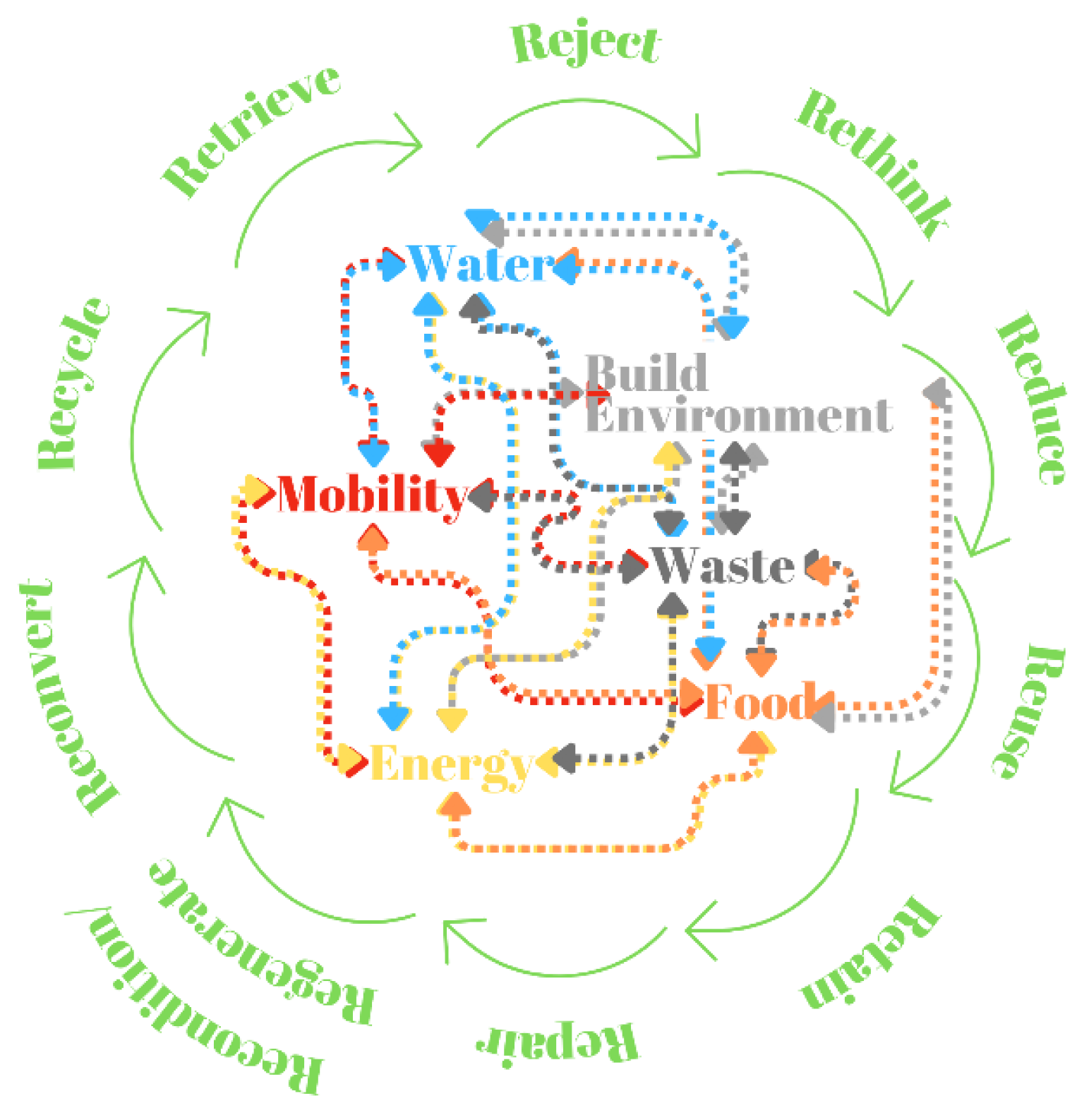
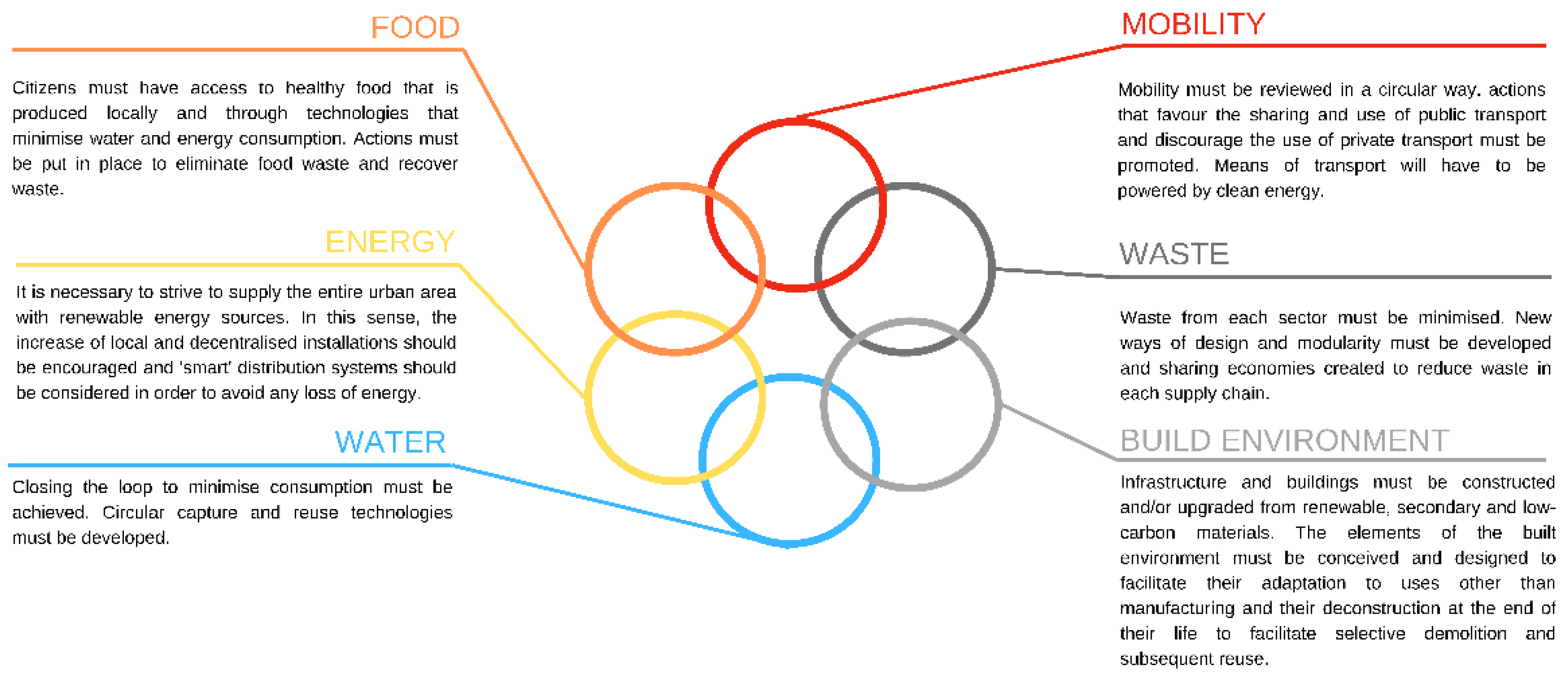
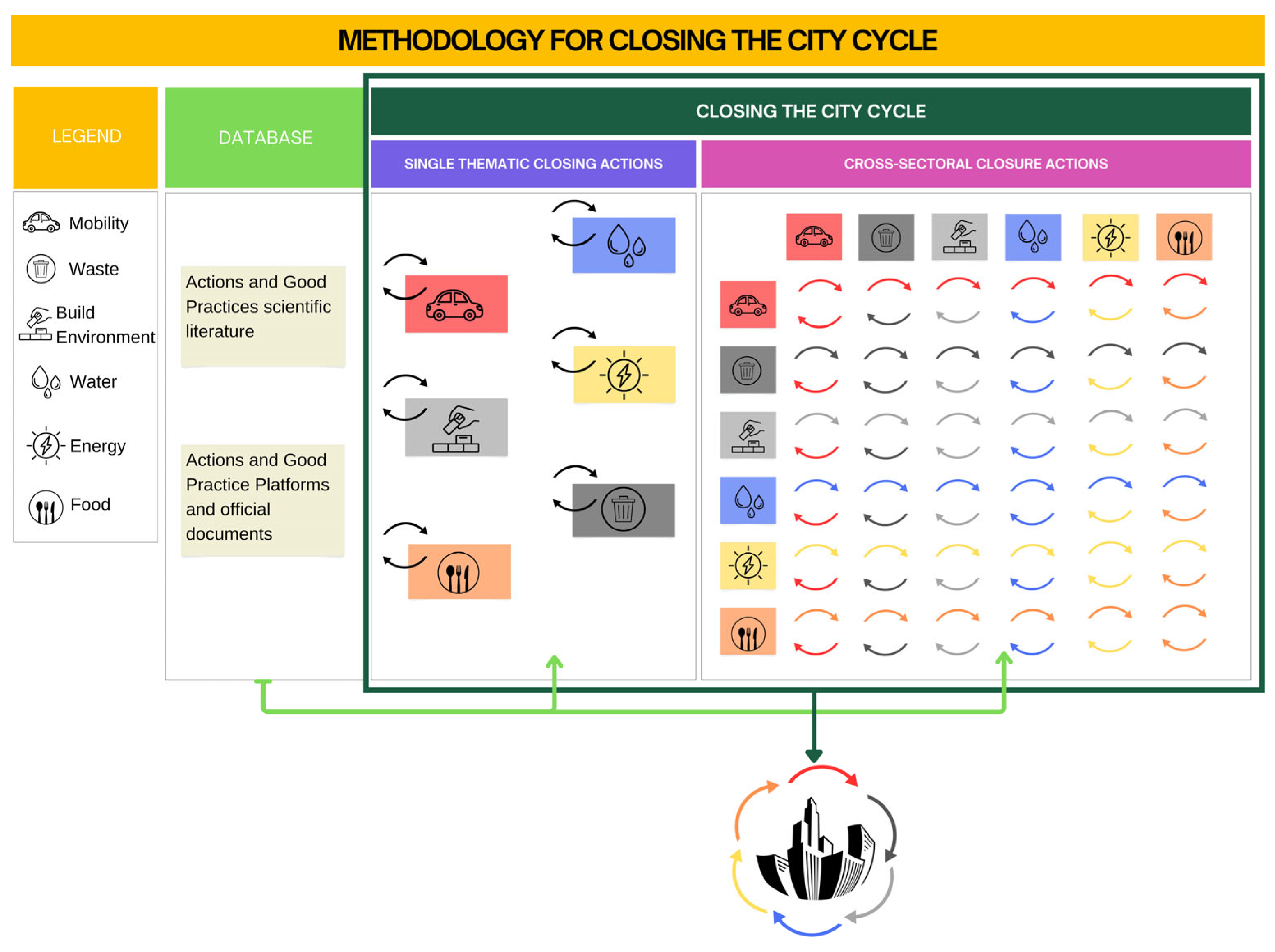
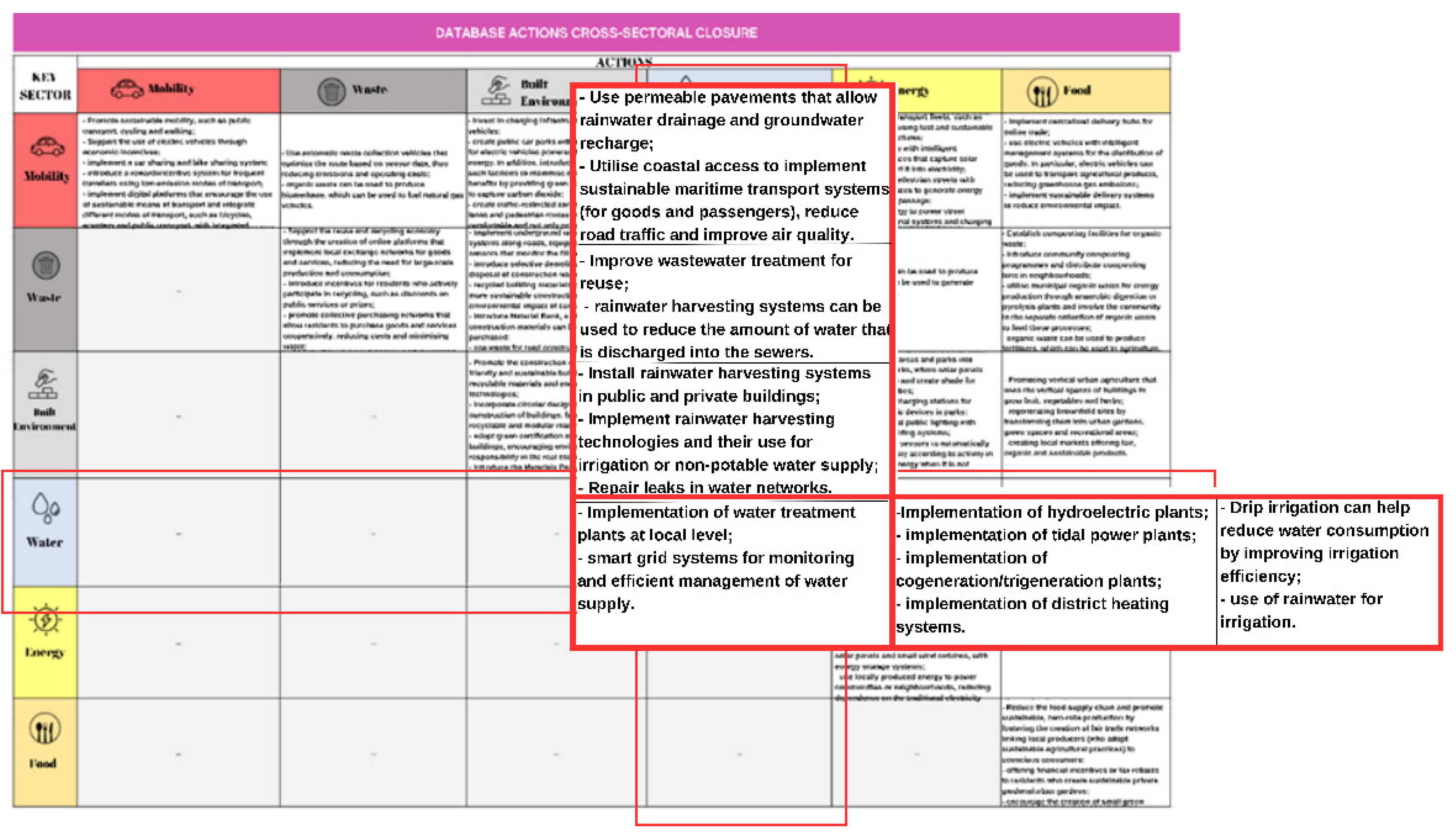
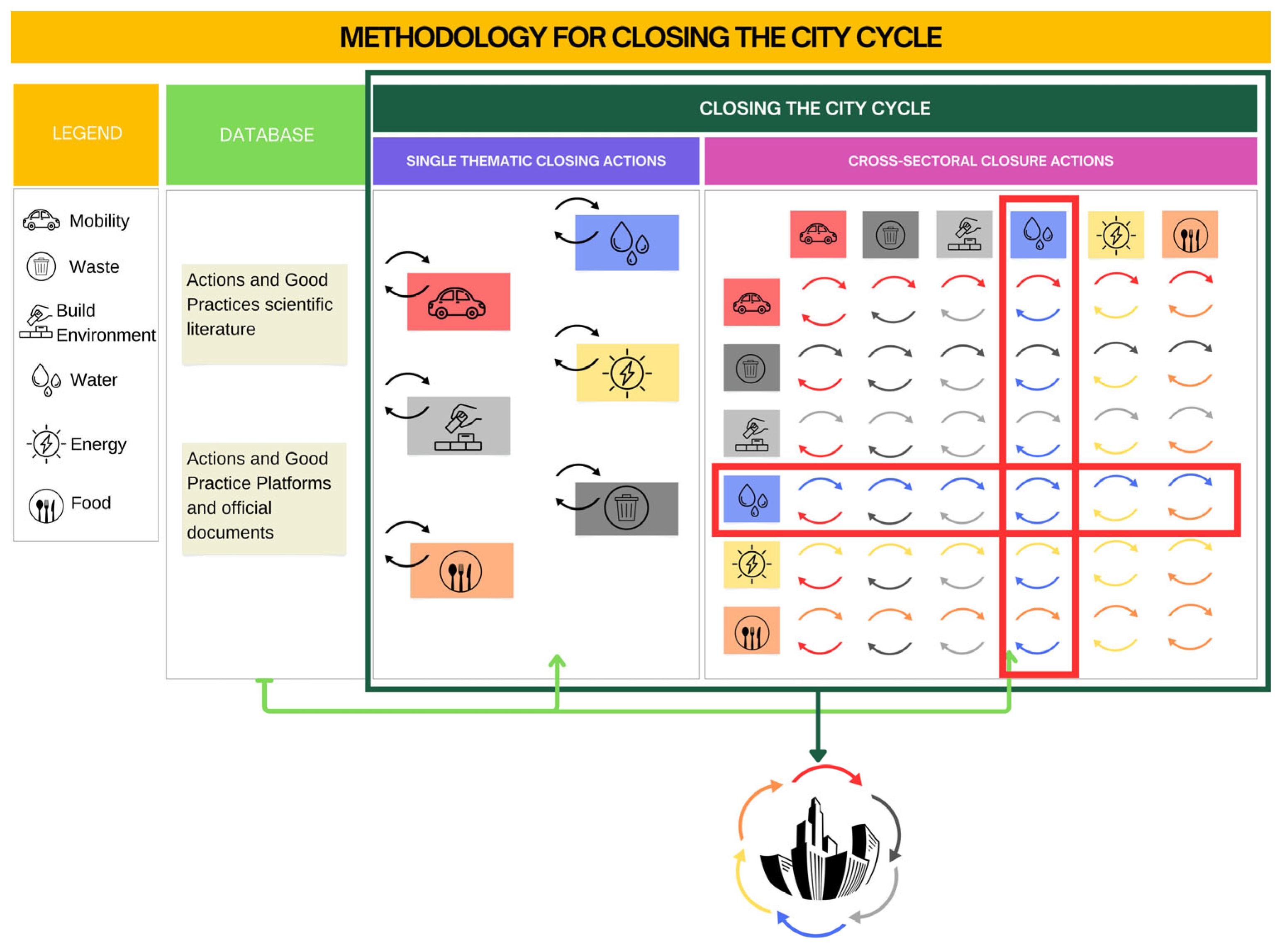
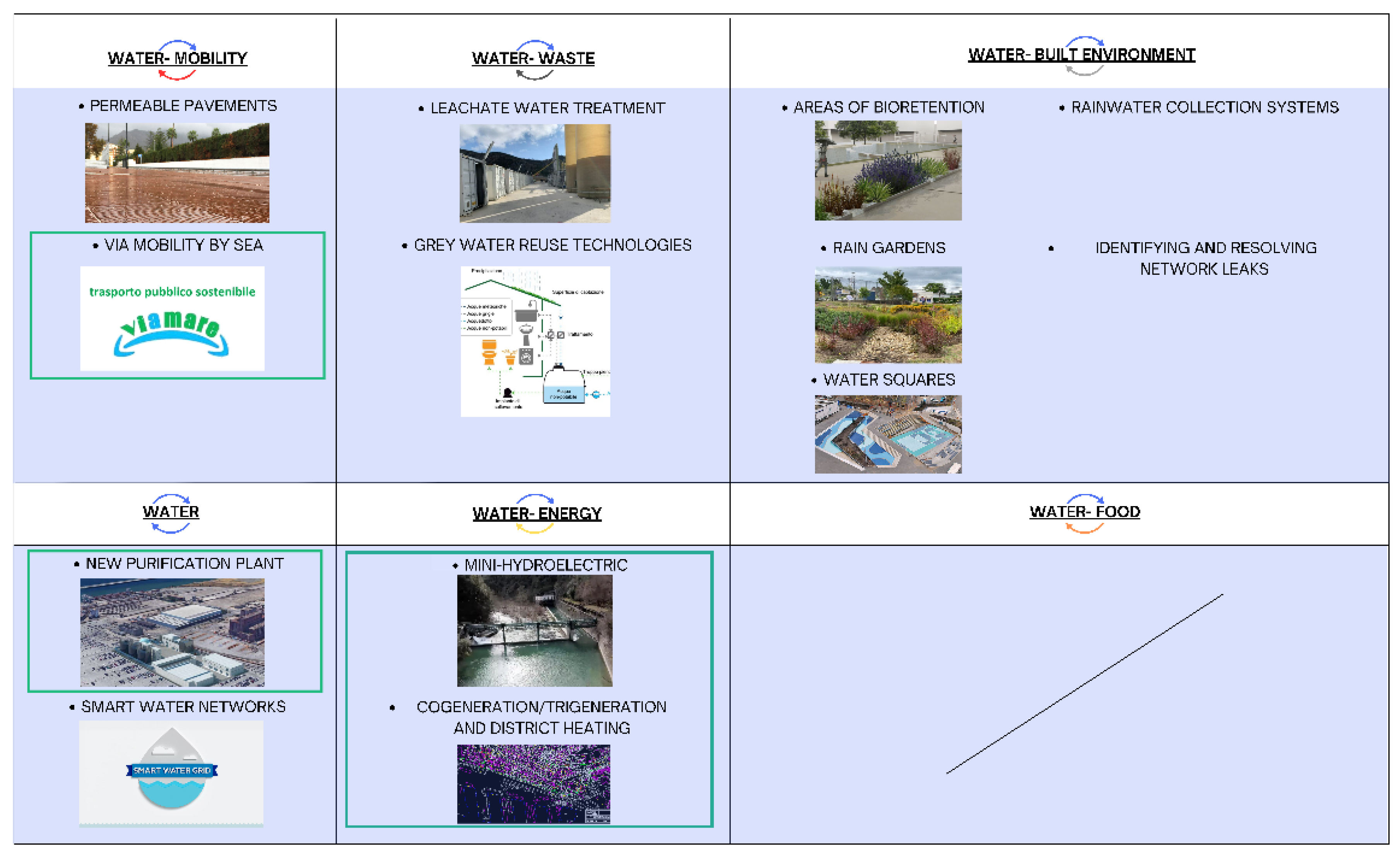
Disclaimer/Publisher’s Note: The statements, opinions and data contained in all publications are solely those of the individual author(s) and contributor(s) and not of MDPI and/or the editor(s). MDPI and/or the editor(s) disclaim responsibility for any injury to people or property resulting from any ideas, methods, instructions or products referred to in the content. |
© 2024 by the authors. Licensee MDPI, Basel, Switzerland. This article is an open access article distributed under the terms and conditions of the Creative Commons Attribution (CC BY) license (https://creativecommons.org/licenses/by/4.0/).
Share and Cite
Paoli, F.; Pirlone, F. Closing the City Cycle: An Approach for Defining Cross-Sectoral Circular Actions to Be Included in a Circular Urban Plan. Sustainability 2024, 16, 7747. https://doi.org/10.3390/su16177747
Paoli F, Pirlone F. Closing the City Cycle: An Approach for Defining Cross-Sectoral Circular Actions to Be Included in a Circular Urban Plan. Sustainability. 2024; 16(17):7747. https://doi.org/10.3390/su16177747
Chicago/Turabian StylePaoli, Federica, and Francesca Pirlone. 2024. "Closing the City Cycle: An Approach for Defining Cross-Sectoral Circular Actions to Be Included in a Circular Urban Plan" Sustainability 16, no. 17: 7747. https://doi.org/10.3390/su16177747
APA StylePaoli, F., & Pirlone, F. (2024). Closing the City Cycle: An Approach for Defining Cross-Sectoral Circular Actions to Be Included in a Circular Urban Plan. Sustainability, 16(17), 7747. https://doi.org/10.3390/su16177747








